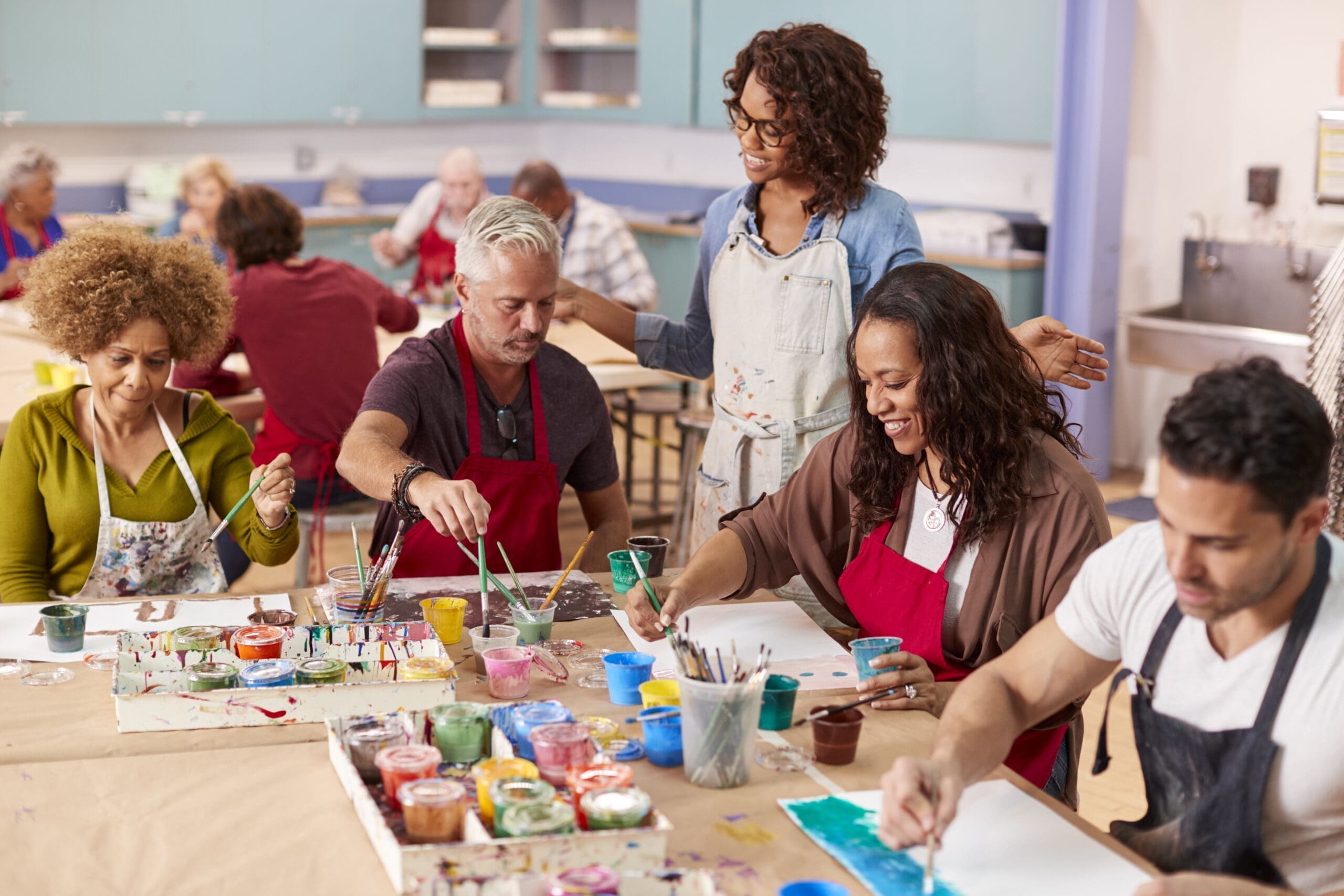
What is Art Therapy?
Art therapy for adults is an innovative way to explore spiritual, emotional, and psychological well-being. It enables individuals to express their thoughts and emotions in a therapeutic environment.
The patients can gain insight into their emotions by engaging in a creative art-making process. Adults can develop healthy coping skills and self-awareness through this form of therapy.
What Do Art Therapists Do?
Art therapists use tools like collages to help the individual create therapeutic art. They teach the patients how to use their artwork to work through complicated emotions.
Art therapy can reduce stress and enable an individual to adjust to difficult life transitions. It is best for individuals looking for a way to find an outlet for self-expression.
How Does Art Therapy for Adults Help?
Art therapy dives deep into enabling individuals to express themselves with creative materials. It may involve psychotherapy and talk therapy. Art therapy helps adults develop strategies to learn about themselves and ask questions.
According to research from 2000 to 2017, 27 studies in art therapy showed the effectiveness of art therapy with adult clients. A principle behind this therapy is that it addresses and uncovers subconscious issues influencing the individual’s behavior.
Benefits of Art Therapy for Adults
Some of the benefits of art therapy for adults are detailed below.
Boosts Self-Esteem
Art therapy helps individuals build healthy habits such as social skills and self-esteem. It gives the individual a sense of accomplishment, thereby boosting self-esteem.
Art therapy enables the individual to build the confidence required to solve life events. Creating art increases dopamine which helps to boost concentration.
According to research by Kendra Ray and Girja Kaimal, 45 minutes of free art-making in a studio monitored by an art therapist is enough to increase self-efficacy.
Stress Relief
Creating art can distract and calm the mind. Art soothes and enables the mind to focus on positive experiences, helping the individual relax.
It serves as an outlet for the individual to express their feelings without feeling judged. This therapy form helps individuals practice mindfulness.
Improves Problem-Solving Skills
Art therapy helps to reduce anxiety and stress. This enables the individual to think more clearly. Thinking more clearly helps develop creative solutions to issues they may face. It encourages goal setting, which is vital for solving problems and achieving desired results.
Art therapy for adults opens the mind to seek other ways to solve problems than alcohol or drugs. It is helpful for individuals struggling to keep up with rapid changes in their lives.
Addresses Past Trauma
Most individuals with substance use disorder use these substances to block out past trauma. Art therapy can help individuals process and understand their past trauma in a safe environment. They will learn to express their feelings about their trauma in a positive way.
Art therapy for adults enables individuals to access their traumatic memories in a controlled environment. They will be able to gain insights into the effects of the trauma in their lives.
Serves as a Positive Distraction
Art therapy for adults provides a positive distraction from daily stressors and psychological issues. It enables individuals to focus on productive and creative activities.
This form of therapy enables individuals to focus on positive thoughts. It can keep one’s mind off of negative thoughts and cravings.
Encourages Self-Awareness and Expression
Art therapy allows people to access their emotions through a creative process. It enables them to express their feelings through art. Art provides an opportunity for people to explore difficult topics more freely. It serves as an outlet for physicalizing emotions that may be felt as intangible.
Through creating physical representations of feelings, individuals learn to understand them. During art therapy, the individual will gain an insight into their emotional state.
Relieves the Burden of Chronic Health Conditions
Art therapy is a holistic approach to healthcare. It is a form of therapy that helps with chronic health conditions.
Through art-making, individuals can creatively express their emotions and feelings. Art therapy encourages people to explore and make sense of emotions related to their health condition.
It helps to improve physical healing by releasing tension and helping the body relax. Art therapy can also help people understand their condition and its impact on their lives. It promotes self-discovery and helps the individual manage their health condition.
Reduces Depression
Art therapy uses creative activities to help people resolve psychological issues. It is an effective tool for managing depression.
Art therapy helps to reduce symptoms such as anxiety and negative thinking. It enables these individuals to gain insight into their feelings that may contribute to depression.
Comparison to Other Forms of Therapy
Art therapy for adults is a unique approach to therapy. It involves using creative mediums such as music, painting, drawing, and sculpting.
Talk Therapy vs. Art Therapy
Talk therapy primarily focuses on verbal conversations between the client and the therapist. However, art therapy allows for an expressive dialogue between the two. Art therapists help their clients to communicate difficult thoughts and experiences in a non-verbal way.
Focus on Symbolism
A major difference between talk therapy and art therapy is the focus on symbolism. Talk therapists look at the patient’s thoughts and behaviors regarding their direct meaning.
In art therapy, therapists can explore deeper meanings embedded within the artwork created by the patient. Art therapists can also explore how physical sensations link to certain artwork.
Compared to other forms of therapy, art therapy for adults uses artistic expression as a therapeutic process. It helps explore personal issues in a non-judgmental environment to understand feelings better.
Types of Activities Used in Art Therapy for Adults
There are many different types of art therapy. Some of these methods are detailed below.
Sculpture
Sculpture in art therapy for adults involves the carving of a figure out of hard material. Here, the individual creates a three-dimensional artwork that shows the dimensional view for the client.
Sculpting shows the individual they can approach situations from various points of view. It also involves shaping materials to represent feelings, emotions, and ideas.
Benefits of Sculpture
This activity is a tactile art form that might help to improve the individual’s psychological attributes. It gives the individual the opportunity to construct and shape their environment. Some additional tools required for this activity may include carving and decorative items.
The physical act of working with the material can become therapeutic in itself. It allows the individual to understand their emotions better and gain insight into their world.
Sculpture activity in art therapy can be beneficial in many ways, allowing individuals to gain a greater understanding of the self.
Painting
Painting is a tool for healing, expression, and self-exploration in art therapy for adults. Creating images allows individuals to express their thoughts, emotions, and beliefs.
Benefits of Painting
Painting helps individuals to build confidence and foster creativity while providing an outlet for stress relief. When used with other therapeutic techniques, it helps access difficult emotions.
Through painting, individuals can engage in a creative activity that enables them to gain self-awareness. It also helps to reduce anxiety and provide relaxation from everyday stress.
Art therapists use painting activities to facilitate personal growth and healing.
Drawing
Drawing is a popular form of art therapy for adults. It involves the creative process of making art to improve mental health. Most individuals are familiar with this activity; therefore, they require little instruction.
Benefits of Drawing
The activity focuses on various outcomes, such as hope, feelings, and dreams. Drawing is an activity often used in group settings for individuals to explore their relationships and identity.
It is an effective treatment for individuals with mental health and physical disorders. Drawing helps the patient to develop better coping skills for life challenges.
Collage
Collage is an activity that involves the use of materials such as fabric and paper to create an artwork. It is a creative process often used in art therapy to explore and express feelings.
Creating a collage is an opportunity for self-expression that does not require verbalization. It enables the individual to explore images, themes, and ideas in a non-judgmental way.
Benefits of Collage Activities
This activity can provide an insight into the individual’s emotional experience. It allows individuals to represent their feelings through textures, symbols, and colors.
When creating a collage, the art therapist asks the individual to create a piece that reflects their current mood. The art therapist then uses the collage to explore the client’s feelings and thoughts further.
Photography
Photography is a form of art therapy for adults that uses photography as a medium of self-expression. Art therapists use this activity to create meaningful connections with their patients.
Benefits of Photography
Photography helps individuals to incorporate memories and the digital manipulation of those images. It enables individuals to capture their perspectives of the world. Photography also helps these individuals to think deeply about their environment.
Skills or Artistic Abilities Needed to Participate in Art Therapy for Adults
There is no need for previous expertise in art to participate in art therapy for adults. However, the type of artistic activities and skills needed often vary depending on the type of art therapy.
Adults participating in art therapy must possess basic drawing and collage-making skills.
Ability to Express Oneself Through Creativity
The ability to express oneself through creativity is an essential aspect of art therapy for adults. This might include writing poetry or stories, creating a visual journal, or engaging in drama or movement.
Awareness of Feelings
These individuals should also know their feelings before participating in art therapy for adults. Art therapists work with their clients to find ways to interpret and express the underlying emotions.
Art therapy can help adults learn how to understand their emotions better and how to cope better with life’s challenges.
Mental Health Conditions that Art Therapy Can Treat
Art therapy helps to treat a variety of mental health conditions. These conditions include:
- Depression
- Anxiety
- Post-traumatic stress disorder (PTSD)
- Eating disorders
- Substance abuse problems
It is particularly effective in helping people cope with grief, trauma, and life transitions. Art therapy for adults also helps people with physical disabilities and chronic illnesses manage physical pain.
It provides support for those who are struggling with feelings of isolation or loneliness.
What to Expect During an Art Therapy Session
An art therapy session typically involves talking, creating art, and reflecting on the experience. The therapist will often guide you to help you explore your feelings related to the artwork. Depending on the client’s needs, art therapists may also use additional activities such as storytelling and guided imagery.
Talking Through Artwork
During an art therapy session, the therapist may prompt you to talk about your artwork and how it might relate to your emotions and life experiences. The art therapist will help you interpret the meaning of the artwork that you create.
Length of treatment
The length of art therapy treatment depends on the needs of each client. It may range from eight to fifteen weeks.
Depending on the issue’s complexity, it can range from a few sessions up to several years. The therapist and client will discuss the goal of the treatment and make any necessary adjustments.
Should Art Therapy be Combined with Other Treatments?
Combining art therapy for adults with other evidence-based treatments, such as CBT, helps people manage their mental health issues. When combining art therapy with CBT, the therapist will use both modalities to work through different aspects of a person’s well-being.
This combination allows for a more comprehensive, tailored treatment plan and a flexible approach. It should also only be combined after thorough experimentation with other strategies.
Art Therapy for Adults at True Life Care
True Life Care is a mental health facility that offers various treatment programs, such as art therapy. At this facility, some medical practitioners ensure each patient receives care to aid recovery.
Art therapy for adults at True Life Care enables individuals to deal with strong emotions through creative expressions. At our facility, our team provides a holistic treatment model, such as art therapy, in an inclusive environment.
Receiving Treatment at True Life Care
True Life Care is a facility that offers primary mental health services. Our facility has knowledgeable and professional staff to cater to everyone’s needs. We provide individualized care and treatment tailored to the individual’s needs.
We also offer structured housing, enabling patients to recover in a comfortable environment.
Our Treatment Model
At True Life Care, we use holistic treatment models such as art therapy to aid recovery. We also offer outpatient mental programs. We provide our patients with individualized care and support to help with a steady recovery.
Contact True Life Care Today
If you or someone you know is interested in art therapy for adults, reach out to True Life Care today. To learn more about art therapy treatment in New Jersey, contact our admission office for more informations.
Resources
- https://arttherapy.org/about-art-therapy/
- https://www.ncbi.nlm.nih.gov/pmc/articles/PMC6124538/
- https://newsblog.drexel.edu/2016/09/16/study-just-45-minutes-of-art-making-improves-self-confidence/
- https://www.canr.msu.edu/news/the_benefits_art_therapy_can_have_on_mental_and_physical_health
















